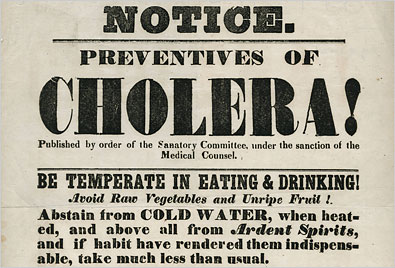Which city saw the first appearance of cholera today in 1832?
 February 13, 1832 — London saw its first appearance of Cholera Morbus today.
February 13, 1832 — London saw its first appearance of Cholera Morbus today.
The infection of the small intestine by some strains of the bacterium Vibrio cholerae cause watery diarrhea, vomiting and muscle cramps, as well as severe dehydration and electrolyte imbalance.
Spread mostly by water and food that has been contaminated with human feces containing the bacteria, insufficiently cooked seafood can also be a source. Humans are the only animal affected. Seven cholera pandemics have occurred in the past 200 years, with the 7th pandemic originating in Indonesia in 1961.
From the Greek word χολή kholē “bile”, the disease originated in the Indian subcontinent and has been prevalent in the Ganges delta since ancient times. It first spread by trade routes (land and sea) in the Bengal region of India starting in 1817 through 1824, and spread to Russia.
The second pandemic lasted from 1827 to 1835 and affected North American and Europe particularly due to the result of advancements in transportation and global trade, and increased human migration, including soldiers.
The third pandemic erupted in 1839, persisted until 1856, extended to North Africa, and reached South America, for the first time specifically infringing upon Brazil. Cholera hit the sub-Saharan African region during the fourth pandemic from 1863 to 1875.
The fifth and sixth pandemics raged from 1881–1896 and 1899–1923. These epidemics were less fatal due to a greater understanding of the cholera bacteria. Egypt, the Arabian peninsula, Persia, India, and the Philippines were hit hardest during these epidemics, while other areas, like Germany in 1892 and Naples from 1910–1911, experienced severe outbreaks.
The final pandemic originated in 1961 in Indonesia and is marked by the emergence of a new strain, nicknamed El Tor, which still persists today in developing countries.
Sources
Words of Wisdom
Thus did the fatal disease rise like a demon bent on destruction; it took its course, not heeding mountain, sea nor clime; death was its object, man its victim, and the uttermost ends of the world its destination; wherever its cold hand was extended - the people died .... Death struggled with time itself, and gnawed the moments that separated him from his victim.




